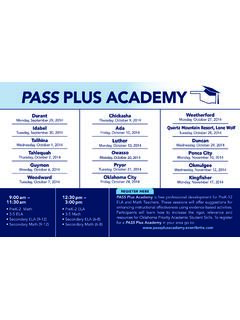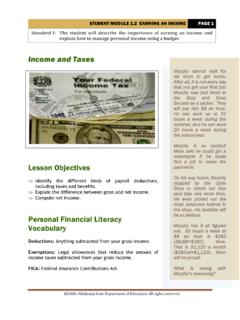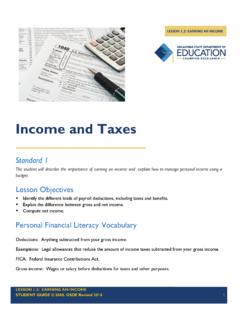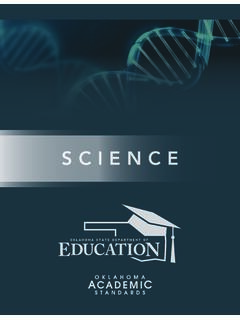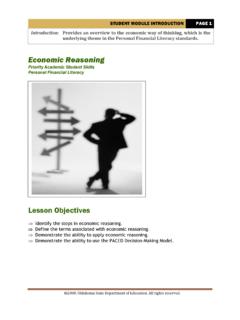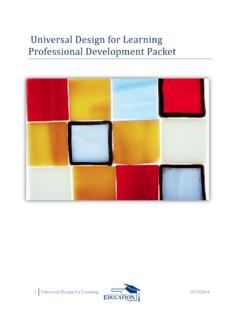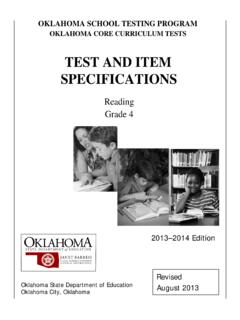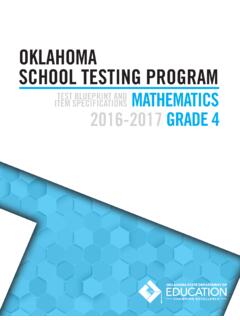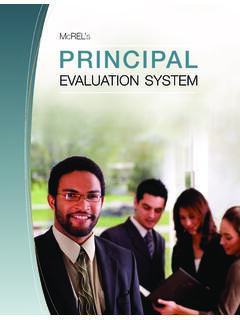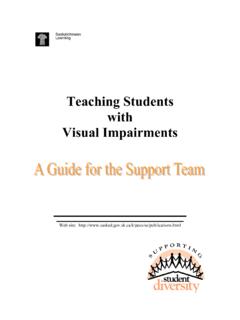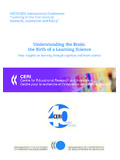Transcription of Guidelines for Transportation of Students with Special Needs
1 Guidelines for Transportation of Students with Special Needs Definition of Transportation INDIVIDUALS WITH DISABILITIES EDUCATION ACT The federal regulations for implementation of the Individuals with Disabilities Education Act (IDEA) define Transportation as follows: 34 CFR Related Services. (October 12, 2006) (16) Transportation includes (i) Travel to and from school and between schools; (ii) Travel in and around school buildings; and (iii) Specialized equipment (such as Special or adapted buses, lifts, and ramps), if required to provide Special Transportation for a child with a disability. 34 CFR Nonacademic services. (October 12, 2006) The State must ensure the following: (a) Each public agency must take steps, including the provision of supplementary aids and services determined appropriate and necessary by the child s IEP Team, to provide nonacademic and extracurricular services and activities in the manner necessary to afford children with disabilities an equal opportunity for participation in those services and activities.
2 (b) Nonacademic and extracurricular services and activities may include counseling services, athletics, Transportation , health services, recreational activities, Special interest groups or clubs sponsored by the public agency, referrals to agencies that provide assistance to individuals with disabilities, and employment of Students , including both employment by the public agency and assistance in making outside employment available. SECTION 504 OF THE REHABILITATION ACT OF 1973 34 CFR Discrimination prohibited "..No otherwise qualified handicapped individual in the United States shall, solely by reason of his handicap, be excluded from participating in, be denied the benefits of, or be subjected to discrimination under any program or activity receiving federal financial assistance." In general terms, Section 504 of 93-112(1), a part of the Rehabilitation Act of 1973, states that all eligible Students with disabilities are entitled to a free, appropriate public education.
3 It also requires the facilities, services, and activities provided to the disabled be comparable to those provided to the nondisabled, and that Students with disabilities must have an equal opportunity for participation in any nonacademic and extracurricular services and activities provided by a school district. In accordance with Section 504, it is possible for a school district to be required to provide specialized Transportation services to a student with disabilities who is not in Special education. Introduction The purpose of this manual is to recommend standard policies, procedures, and Guidelines for persons entrusted with the responsibility of managing Transportation for Students with Special Needs . The term Special Education means specially designed instruction to meet the unique Needs of a child with a disability. Transportation is one of the related services required when necessary for a child to benefit from Special education.
4 The Guidelines , policies, and procedures recommended contain adequate information to guide those persons responsible for pupil Transportation in developing an action plan for the safe delivery of Transportation services to Students with Special Needs . Definitions of Disabilities Under IDEA Autism - a developmental disability significantly affecting verbal and nonverbal communication and social interaction, generally evident before age three, that adversely affects a child's educational performance. Other characteristics often associated with autism are engagement in repetitive activities and stereotyped movements, resistance to environmental change or change in daily routines, and unusual responses to sensory experiences. The term does not apply if a child's educational performance is adversely affected primarily because the child has an emotional disturbance.
5 Deaf-Blindness - a concomitant hearing and visual impairment , the combination of which causes such severe communication and other developmental and educational problems that they cannot be accommodated in Special education programs solely for children with deafness or children with blindness. Deafness - a hearing impairment so severe that the child is impaired in processing linguistic information through hearing, with or without amplification, that adversely affects a child's educational performance. Hearing impairment - an impairment in hearing, whether permanent or fluctuating, that adversely affects a child's educational performance, and is not included under the definition of deafness in this section. Mental Retardation - significantly subaverage general intellectual functioning existing concurrently with deficits in adaptive behavior and manifested during the developmental period that adversely affects a child's educational performance.
6 Multiple Disabilities - concomitant impairments (such as mental retardation, blindness), the combination of which causes such severe educational Needs that they cannot be accommodated in Special education programs solely for one of the impairments. The term does not include deaf-blindness. Orthopedic impairment - a severe orthopedic impairment that adversely affects a child's educational performance. The term includes impairments caused by congenital anomaly ( , clubfoot, absence of some member, etc.), impairments caused by disease ( , polio militias, bone tuberculosis, etc.), and impairments from other causes ( , cerebral palsy, amputations, and fractures or burns that cause contractors). Other Health Impairments - having limited strength, vitality or alertness, including a heightened alertness to environmental stimuli, that results in limited alertness with respect to the educational environment, that is due to chronic or acute health problems such as asthma, attention deficit 2 disorder or attention deficit hyperactivity disorder, diabetes, epilepsy, a heart condition, hemophilia, lead poisoning, leukemia, nephritis, rheumatic fever, sickle cell anemia, and Tourette syndrome; and adversely affects a child's educational performance.
7 Speech or Language impairment a communication disorder, such as stuttering, impaired articulation, a language impairment , or a voice impairment , that adversely affects a child s educational performance. Emotional Disturbance - a condition exhibiting one or more of the following characteristics over a long period of time and to a marked degree, that adversely affects educational performance: (A) An inability to learn that cannot be explained by intellectual, sensory, or health factors; (B) An inability to build or maintain satisfactory interpersonal relationships with peers and teachers; (C) Inappropriate types of behavior or feelings under normal circumstances; (D) A general pervasive mood or unhappiness or depression; or (E) A tendency to develop physical symptoms or fears associated with personal or school problems. The term includes schizophrenia. The term does not apply to children who are socially maladjusted, unless it is determined that they have a serious emotional disturbance.
8 Specific Learning Disability - a disorder in one or more of the basic psychological processes involved in understanding or in using language, spoken or written, that may manifest itself in an imperfect ability to listen, think, speak, read, write, spell, or to do mathematical calculations. The term includes such conditions as perceptual disabilities, brain injury, minimal brain dysfunction, dyslexia, and developmental aphasia. The term does not apply to children who have learning problems that are primarily the result of visual, hearing, or motor disabilities, of mental retardation, of emotional disturbance, or of environmental, cultural, or economic disadvantage. Traumatic Brain Injury - an acquired injury to the brain caused by an external physical force, resulting in total or partial functional disability or psychosocial impairment , or both, that adversely affects a child's educational performance.
9 The term applies to open or closed head injuries resulting in impairments in one or more areas, such as cognition; language; memory; attention; reasoning; abstract thinking; judgment; problem-solving; sensory, perceptual and motor abilities; psychosocial behavior, physical functions; information processing; and speech. The term does not apply to brain injuries that are congenital or degenerative, or brain injuries induced by birth trauma. Visual impairment - impairment in vision that, even with correction, adversely affects a child's educational performance. The term includes both partial sight and blindness. Developmental Delays children aged three through eight experiencing a significant delay in one or more of the following areas: physical development, cognitive development, communication development, social or emotional development, or adaptive development; and who, by reason thereof, need Special education and related services.
10 The Role of Transportation Staff in the Individual Education Program (IEP) Process The IEP team is the formal group that designs a student's educational program and establishes goals and objectives, and determines the related services that are necessary for a student to benefit from Special education. The IEP team report most often serves as the basis for IEP team discussions and decisions regarding a student's program content. If it is determined that a student Needs specialized 3 Transportation as a related service, Transportation staff shall be invited to participate in the IEP process and serve as an additional resource. The Transportation staff person could be expected to serve two major functions as a member of the IEP team: 1. The primary function would be to gather information regarding the student's expected Transportation Needs so as to properly plan for a timely, efficient, and safe initiation of Transportation service.
